Cox 020 Rework
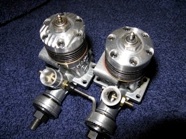
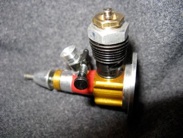
Note: Modification of the TD 020 to use the Nelson style drop-in glow plug is no longer being performed due to difficulties in obtaining consistent performance with available plugs. Other mods and parts continue to be available including repair of previously modified engines.
Initial efforts in adapting the Nelson pug to the Cox TD 020 centered on installing the vertical coil plug. This proved problematical in that the major diameter of the plug is only slightly smaller than the minor diameter of the head recess in the cylinder. The resulting thin wall would more often than not fail at a torque too low to achieve a reliable seal at the plug’s conical surface. The flat coil drop-in Nelson plug at first look provided no benefit in installation but did provide a noticeable performance improvement. After some additional work a design for the flat coil plug was developed which eliminates the minimal wall thickness problem. The head assembly is comprised of two parts, an aluminum head that screws into the 020 cylinder and a brass retaining ring that clamps the plug in place. In developing this head about 100 runs were made on fuel from 50 to 65% nitro and only one plug was burnt out attesting to their durability.
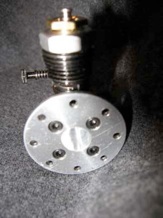
A weak area in the 020 design is the joint between the radial mount and the engine. It can be difficult to obtain a good seal due to deflection of he plastic mount and the case. This is often exacerbate by the lack of proper deburring of the 2-56 mount holes in the case. A good seal can be obtained by deburring the 2-56 tapped holes in the case and use of a small fillet of silicon sealant. During test runs considerable vibration has been observed around 21 to 22000 rpm on most engines. Often the vibration seems to limit the rpm but once the vibration decreases the rpm rapidly increases. This appears more severe for with the red plastic tank mount. To help both the sealing and vibration two aluminum mount are available that along with deburring and silicone sealant provides a very ridged, leak-free mount. The smaller mount matches the hole pattern in the small plastic Cox mount while the larger mount matches the hole pattern in the Cox tank mount.

One thing that I have noticed on the 020 is the variability of the position of the piston at Top-Dead-Center (TDC) relative to the plug/head-sealing surface. Pistons have ranged from 0.006 below the sealing surface to nearly 0.004 above. Exhaust port timing varies from 114 degrees to nearly 130 degrees. It is critical to accurately compensate for these variations to obtain maximum performance. To compensate shims are added below the cylinder to obtain better port timing and between the head and sealing surface. A head is then machined for each engine to provide the proper compression ratio to match the port timing. A 0.0001” dial indicator is used to set the clearance to match the head combustion chamber volume/depth.
As set-up, they will run well on 40 to 65% nitro. My standard test prop is the APC 4.2X2 and the fuel is a 40% nitro blend with 25% oil, and 35% alcohol. If the engine runs at about 27000 rpm or better no further runs are performed. If performance is less a run will be made on 65% nitro with 10% propylene oxide, and 25% oil. Through bitter experience I have found that the 020 may throw parts if run much above 30,000. 65% fuel will probably take an engine over 30,000 if it runs 27,000 on 40%. Aerodyne makes a good 65% fuel. If you mix or buy be sure at least ½ if not more of the oil is castor to help extend the life of the piston ball and socket joint and other bearing surfaces. 65% fuel is recommended for maximum performance but beware of 30,000 and above.
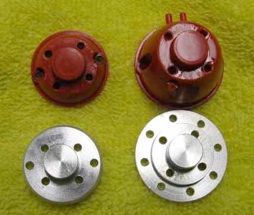
A common modification to the TD 049 is to add flutes to the bypass flow channels. Similar flutes added to the 020 can provide performance improvement along with increasing the venturi diameter.
For any TD 020 modification a brass rub washer is installed on the shaft between the prop drive washer and the case to prevent the aluminum on aluminum wear which results when an electric starter is used. 3-48 socket head screws are provided to replace the round head prop screw.
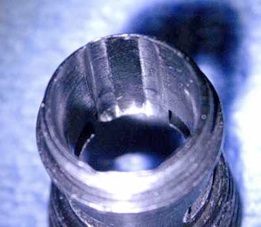
One small but convenient accessory for the 020 is a spinner which concentrically aligns an APC 4.2X2 prop without the need for additional prop shims. The rear hub fits inside the large hole in the center of the prop eliminating the need for separate bushings. It is supplied with a socket head 3-48 screw to replace the stock slot head screw. It is available in either brass (5.7 g) or aluminum (1.9 g). A similar setup is available for the TD 049/051 engines to fit APC props.



If your 020 has the common crack in the carb housing boss for the venturi, a small repair ring is available that is clamped in-place via the screw-in venturi. This ring eliminates further failure of the boss and is installed on any 020 reworked with the crack.
A short movie of a modified TD 020 running at about 25500 rpm can be seen by clicking on the run control in the movie frame to the left.
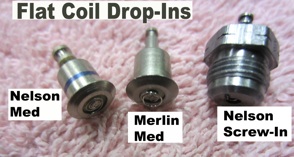
Only problem is that the flat coil drop-in Nelson plug is no longer made but Merlin makes a substitute which can be seen/ordered at http://www.merlinglowplugs.com/Aircraft.html . Specifically I have found that the “GloBee Drop-In MED”, which has a green insulator, and the“GloBee 10”, which has a black insulator, both provide fair performance with the GloBee green being best. The plugs are located near the bottom of the above web page. Note that the illustration on the Merlin web site does not look like the actual plug shown here. Due to the lack of the Nelson flat coil plug I have quit modifying the TD 020 to use the drop-in plugs as equal performance can be obtained with stock Cox plugs.